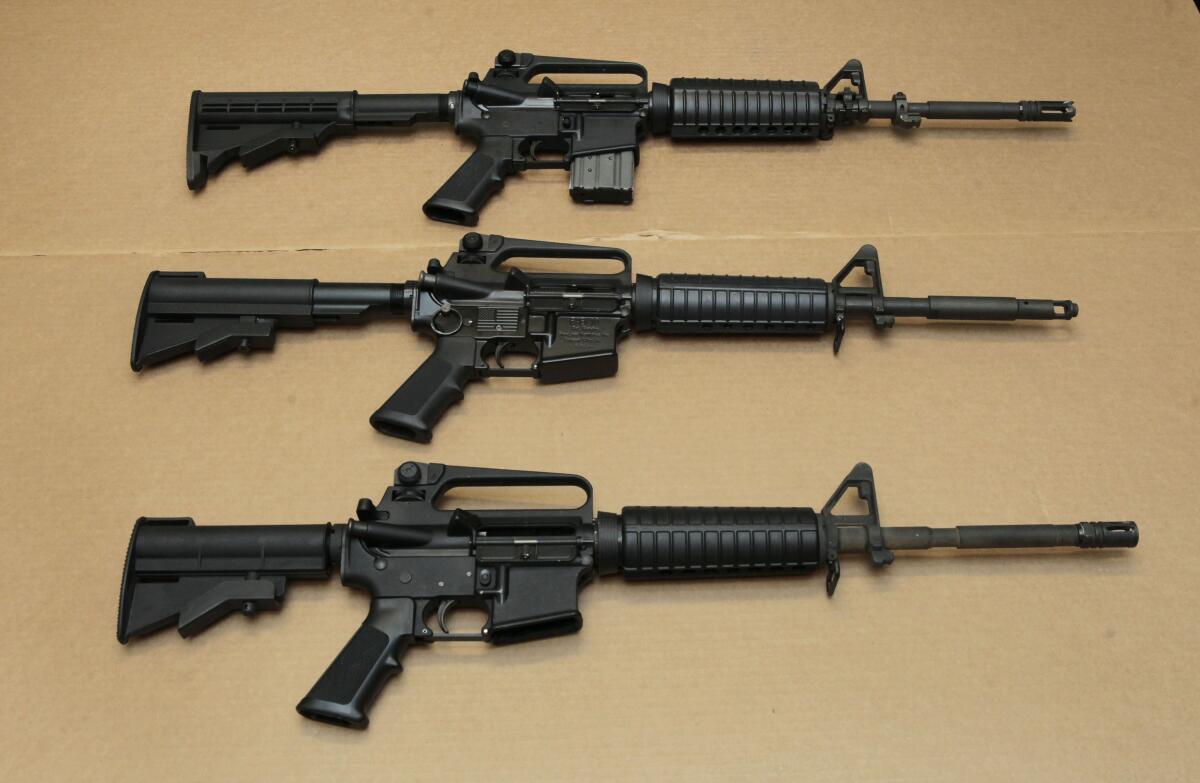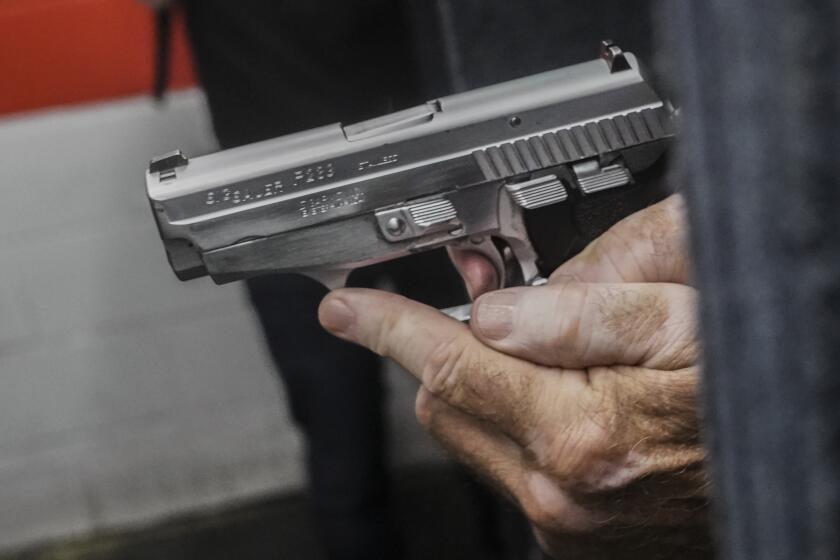Will latest Supreme Court decision affect California bans on assault weapons, magazines?

A long-awaited U.S. Supreme Court decision upholding a federal law barring domestic abusers from possessing firearms will have a narrower impact than some had hoped, but it will nonetheless play an important role in reshaping gun laws in California and across the country, legal experts said.
Among the laws Friday’s decision could affect are California’s bans on assault-style weapons and large-capacity ammunition magazines, both of which are facing legal challenges in the U.S. 9th Circuit Court of Appeals.
Adam Winkler, a UCLA law professor who focuses on 2nd Amendment law, said nothing in the high court‚Äôs decision in United States vs. Rahimi ‚Äúmakes it crystal clear how those cases are going to play out.‚ÄĚ
But, he said, the decision does give lower court judges a wider legal pathway for finding California‚Äôs modern gun laws legitimate ‚ÄĒ not only if they are hundreds of years old or precisely analogous to some other early American law, but also if they are in line with a broader legal ‚Äúprinciple‚ÄĚ from early American history.
‚ÄúThere‚Äôs no doubt that it‚Äôs a major win for gun safety advocates,‚ÄĚ Winkler said. ‚ÄúThis case sends a broad signal that a majority of justices are not completely hostile to gun laws and that mainstream American gun laws are likely secure ‚ÄĒ even if they‚Äôre not well grounded in history and tradition.‚ÄĚ
In a ruling that limits the 2nd Amendment, the justices vote 8 to 1 that dangerous people who have threatened a domestic partner can lose their right to possess a gun.
Other observers ‚ÄĒ including Chuck Michel, an attorney for some of the gun advocates challenging California‚Äôs laws ‚ÄĒ took a different position, saying the Rahimi decision was pretty narrowly tailored but could open the door to even more challenges to California laws.
The Rahimi decision relied in part on a finding that Zackey Rahimi, the defendant, was dangerous. Michel said there are California laws that allow for guns to be taken from people under restraining orders where no such finding has been made. He said he believes those laws are now more vulnerable to overturning.
More broadly, Michel said, the debate over what constitutes sufficient historical grounds for a modern law to have merit is hardly settled by Rahimi.
‚ÄúThe hairsplitting that is going to go on in determining what is a sufficient historical analogue,‚ÄĚ he said, ‚Äúhas just begun.‚ÄĚ
Legal experts agreed the Rahimi decision will do little to resolve the roiling legal debate over modern American gun laws.
Chief Justice John G. Roberts Jr.‚Äôs decision for the court ‚ÄĒ which Justice Clarence Thomas was alone in dissenting from ‚ÄĒ was broad enough to be construed differently by lower court judges, the experts said. The 8-1 ruling came with five concurring opinions from other justices ‚ÄĒ each distinct ‚ÄĒ that judges and attorneys across the country will also be looking to for guidance.
‚ÄúThere‚Äôs still so much room to interpret history how a judge wants to,‚ÄĚ said Eric Ruben, a 2nd Amendment scholar and fellow at the Brennan Center for Justice at New York University School of Law.
Friday’s ruling follows a monumental Supreme Court decision in 2022, in the case of New York State Rifle & Pistol Assn. vs. Bruen. There, the high court upended American jurisprudence around the 2nd Amendment right to bear arms by rejecting the long-standing notion that governments may enforce certain firearms restrictions if they have a compelling government interest in doing so.
Instead, Thomas wrote for the court in Bruen, most restrictions on firearms are legitimate only if they are deeply rooted in American history and tradition or sufficiently analogous to another historical rule.
The Bruen decision invigorated legal challenges to gun control measures all across the country. It also created conflicting rulings in the lower courts, where judges have interpreted the new standard under Bruen in wildly different ways.
Dozens of other states are taking sides in the court fight over the legitimacy of California’s effort to ban high-capacity ammunition magazines.
Conservative-leaning judges have toppled gun laws by taking a narrow view of what constitutes a sufficient historical analog for a modern law to survive. In September, U.S. District Judge Roger Benitez of San Diego overturned California’s ban on large-capacity ammunition magazines based on Bruen, determining the two-decade-old law had no equivalent in early American history.
‚ÄúBased on the text, history and tradition of the 2nd Amendment, this law is clearly unconstitutional,‚ÄĚ he wrote.
One month later, Benitez overturned California’s three-decade-old ban on assault-style weapons on similar grounds.
‚ÄúTo give full life to the core right of self-defense, every law-abiding responsible individual citizen has a constitutionally protected right to keep and bear firearms commonly owned and kept for lawful purposes,‚ÄĚ Benitez wrote.
The state of California appealed those decisions, and the 9th Circuit paused both as it reconsiders the cases. The ammunition case in particular is now at the front of a long line of California gun cases that have backed up in the appeals court as judges there waited to see if the Supreme Court would provide more guidance on how to interpret Bruen in its Rahimi decision, experts said.
Some liberal-leaning appellate judges have already shown a willingness to take a broader view of historical precedent for modern gun laws than Benitez, and experts said the Rahimi decision further empowers them to find justification for California’s gun laws.
‚ÄúOne of the big questions under Bruen was how close must the historical analogs be? How similar must the laws of yesteryear be to the laws of today?‚ÄĚ said Winkler. ‚ÄúThe court has loosened that aspect of Bruen quite unmistakably.‚ÄĚ
Roberts wrote Friday that the modern law at issue in Rahimi was ‚Äúrelevantly similar‚ÄĚ to historical provisions ‚Äúpreventing individuals who threaten physical harm to others from misusing firearms‚ÄĚ ‚ÄĒ even though those precursor laws were not specifically geared toward domestic abusers.
That was enough to justify the modern law under Bruen, where ‚Äúthe appropriate analysis involves considering whether the challenged regulation is consistent with the principles that underpin our regulatory tradition,‚ÄĚ Roberts wrote.
Roberts‚Äô decision runs counter to lower court interpretations of Bruen that called for an exceedingly similar historical law to be in place in order for a modern law to be upheld, experts said ‚ÄĒ and will have the effect of reining in more extreme pro-gun decisions moving forward.
The latter was clearly the intent of the high court’s majority, the legal experts said.
‚ÄúThe court is trying to climb out of a hole it dug with the Bruen case and the requirement that modern day laws be judged according to whether they are analogous in some ill-defined sense to some tradition,‚ÄĚ Ruben said.
The U.S. 9th Circuit Court of Appeals stops a lower court decision overturning California’s ban on high-capacity ammunition magazines from taking effect.
Still, the debate over modern gun laws is sure to rage on, he and others said.
‚ÄúIt‚Äôs right to say that the court is applying a little bit of a broader conception of historical tradition than many of the [lower] courts considering Bruen,‚ÄĚ said Jake Charles, an associate professor at Pepperdine Caruso School of Law and an expert in firearms law.
But, Charles said, the Rahimi decision ‚Äúdoes not resolve a lot of the open questions‚ÄĚ about other gun laws that are already pending in the courts ‚ÄĒ including around assault-style weapons and large-capacity magazines.
He and other experts said they are watching to see if the Supreme Court takes up more gun cases that are awaiting its consideration, including one related to felons possessing firearms, or if it will choose to send those cases back to lower courts with the instruction that they be reconsidered with Friday’s Rahimi decision in mind.
One way or the other, the experts said, the Supreme Court is going to have to weigh in again, as lower court judges are no doubt going to continue relying on vastly different interpretations of Bruen and, now, Rahimi.
‚ÄúThey‚Äôre going to be busy,‚ÄĚ Ruben said, ‚Äúbecause the splits are going to continue to arise.‚ÄĚ
More to Read
Sign up for Essential California
The most important California stories and recommendations in your inbox every morning.
You may occasionally receive promotional content from the Los Angeles Times.













